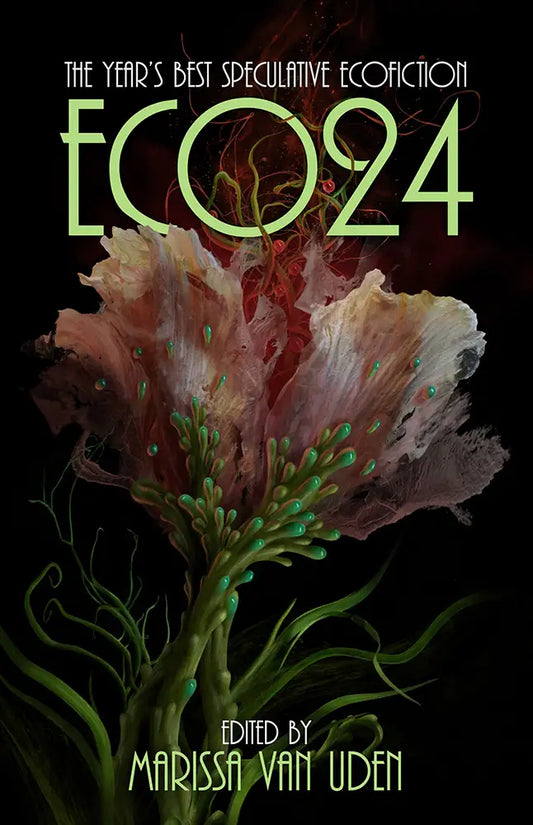
It’s hard to believe we’re already in a new year. The end of the current year, when I’m writing this, is flying by and there’s still so much short fiction to catch up on! Are you trying to catch up too? If so, allow me to add five more pieces to your list, each one lovely, eerie, and uncertain.
“Auscultation” by J.S. Breukelaar, published in The Dark, evokes classic Gothic fiction, and is effectively told as a series of emails sent by Maxine to her lover, Rebecca. Rebecca has thoughtfully arranged a country retreat for Max’s mental health, which, as with many classic Gothics, turns out to have the opposite intent and effect.
The escarpment on both sides of the canyon, perhaps carved by some ancient river, lends a subterranean cast to the place even on the sunny side-my side-by day, and it is utterly dark at night. I’m not talking about the velvet dark of a spring evening in London, by a kind of road-kill black, the colour of rot-pallid stars barely visible in the slit of sky.
The story’s uneasy undercurrent becomes increasingly overt, making it clear Max has been set up. There’s a wealth gap between her and Rebecca, making her vulnerable within their relationship, the power imbalance furthered by Max’s health and her desire to please. The estate where Max stays is revealed to be Rebecca’s ancestral home, and from subtle gaslighting and unease, events escalate to the manor house literally trying to eat Max.
The story perfectly captures the sense of isolation and atmosphere that is a hallmark of the Gothic genre, and effectively plays with the sense of doubt and a character being manipulated and abused. Furthering the nod to classic Gothics, the characters’ names—Rebecca and Max—evoke du Maurier’s novel Rebecca. It’s a lovely spin on a classic genre, and effectively done.
“Cretins” by Thomas Ha, published in Weird Horror, also explores isolation of a sort, with a main character who suffers from Ferrier’s—a sleep disorder that leaves them incredibly vulnerable.
When I started falling asleep uncontrollably, those months before the diagnosis, I don’t think I’d ever been more afraid. My body just giving out from under me. My mind losing time and skipping the surface like a wobbling needle on a record player, playing less and less of a coherent song.
Like Breukelaar’s story, Ha’s features a character seemingly at a disadvantage in the world, relying on the kindness of strangers, which is increasingly hard to find. They’ve been robbed under the guise of an offer of help. They’ve also been mocked and outright attacked. As the story opens, they are convinced they are being stalked by someone who wishes them harm while they sleep, and from increasing paranoia, they find a way to turn the tables to secretly record and watch the person watching them.
The story takes further turns from there, flipping the scenario from one of fear to a search for human connection, before circling back around to obsession. Isolation and the desire to be understood by others is taken to the extreme, leading to deeply unhealthy behaviors, and providing a satisfyingly creepy tale. The pacing and progression of these events is handled perfectly, so the reveal of what is truly going on in the story feels earned.
“Jack O’Dander”by Priya Sharma, published at Tor.com, takes readers into the territory of eerie urban legends. As a child, Natalie’s older sister, Isobel, and their cousin, Ellen, introduced her to the story of Jack O’Dander—a disturbing figure dressed in black, appearing in the background of online videos. The trick to the legend is not everyone can see him, but if you do, that means he’s seen you and he’ll come find you.
When I glanced back at the phone, Jack O’Dander had stepped out from beneath the trees. He walked to the kerb and looked up. The streetlamp cast a shadow from the brim of his hat, hiding his face, but I could tell he was staring towards the window. In that moment, it looked like he was staring at me.
Natalie sees him, but Ellen and Isobel claim they don’t, leaving Natalie terrified. Natalie’s fear only exacerbates the tension already running through the family with Natalie’s mother and aunt fighting, Natalie feeling excluded by her sister and cousin, and Isobel being the favored child while Natalie can’t seem to do anything right in her mother’s eyes. During the family vacation they’re all taking together, Isobel disappears—taken by Jack O’Dander, as far as Natalie is concerned.
As an adult, Natalie is still trying to cope with the trauma of her sister’s disappearance. She joins an online support group and makes a connection with another member, but sharing their experiences brings up old memories and pain. Natalie begins questioning her new friend’s motives, as he seems far more interested in Isobel and the details of her disappearance than he is in Natalie as a person and her journey toward healing.
Sharma does an excellent job of capturing the creepy urban legend vibe in her descriptions of Jack O’Dander. The doubt she casts on Natalie’s experiences, as both a child and an adult, is perfectly done. The story works on multiple levels, as a straightforward supernatural horror, and as a commentary on survivor’s guilt, complex family relationships, trauma, and healing. The story is frightening no matter which lens you apply—supernatural or mundane horror—and the doubt and gray spaces that allow it to be read either way makes it all the more effective.
“There Are Only Two Chairs, and the Skin is Draped Over the Other” by Alexia Antoniou, published in Bourbon Penn, is a wonderfully surreal story about two girls who discover an empty human skin in the creek behind one of their houses.
She is holding what is, terribly, the face of the skin. She’s got it spread across her two hands, holding it with her fingertips like she’s about to play cat’s cradle. She is staring softly through wetly clumped lashes into the empty holes that must be the skin’s eyes.
Despite being unsettled by the discovery, the girls begin incorporating the skin into their games of make believe. The line between fantasy and reality quickly blurs. The narrator may have feelings for her friend Catherine, using the skin to speak for her and express her interest. It’s equally possible that the skin is exerting its own influence over one or both girls in a kind of possession, speaking through them and changing their behavior.
Like Sharma’s story, the uncertainty and spaces left for doubt only increase the story’s effectiveness. The imagery of the empty skin is striking, and the girls’ behavior, seeming a little off throughout the story, only adds to the dreamlike/nightmare effect of the piece. It’s an uneasy story either way, and all the more enjoyable for not providing any concrete answers.
“Zoraida la Zorra” by Ana Hurtado, published in The Dark, also plays in this space of doubt, tapping into myth with Zoraida—a character who may also be a supernatural creature feeding off of her best friend.
It’s also perfectly possible that Zoraida is simply a woman who wants to live on her own terms, free of the judgment of others, who wishes her best friend would do the same. Zoraida doesn’t approve of her friend Ari’s boyfriend, but neither does the boyfriend approve of her, fearing she is a bad influence on Ari. He refers to her as a slut, and calls her other names, but Zoraida remains unapologetic, with no intention of changing to suit anyone else’s idea of what she should be. Meanwhile, Ari is growing sicker and weaker, without a concrete explanation, but her illness is seemingly tied to several other young women who have all been lured into the river and swept away.
When a body is missing, when a young woman never comes home, when the Text me when you get there message is left unread, the police eye the riverscape for an obsidian bird towing las olvidadas from el río lloron, fighting shrieking with shrieking.
Hurtado hints at a longing between Zoraida and Ari that is never acted upon. It adds another dimension to their relationship, and the story’s exploration of how women are expected to be compliant, suppress their own wishes and personalities, and make themselves more appealing and socially acceptable. When they are not, they are punished—called bitches, sluts, or suffer and sicken the way Ari does. However, Ari suppressing her true self and her feelings may be the very thing that’s leading to her sickness, and if she learns to let go, she will be free. As with the other pieces discussed here, the ambiguity works well, allowing the story to be read on multiple levels. The writing is gorgeous, and full of poetic prose and striking imagery, making it effective no matter how it is read.












